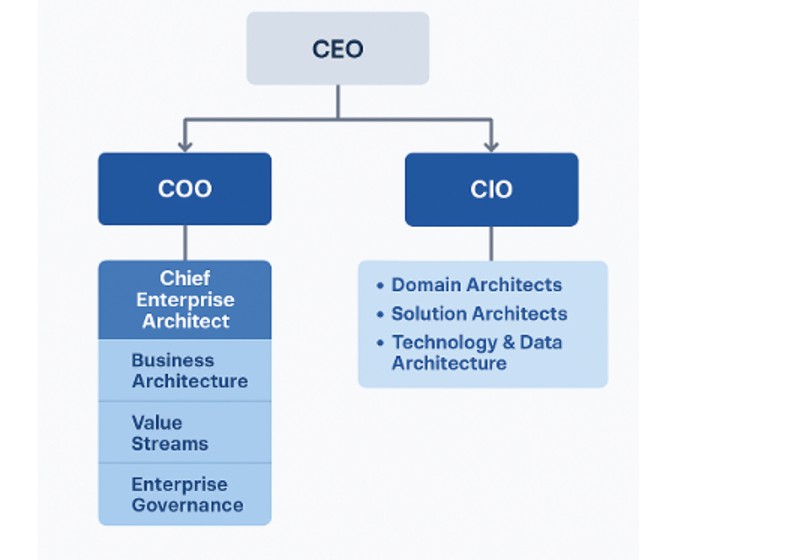
By Prabhakar V
The COO turns to the Enterprise Architect during an operations review: “Can we shift our aftermarket business to a servitized model in the next 180 days?” If your first thought is about system interfaces instead of service capability design, that’s the problem.
That single moment, which I’ve experienced firsthand, captures how much the Enterprise Architect (EA) role needs to evolve.
For too long, enterprise architecture has been viewed primarily as a technology discipline, an enforcer of standards, a guardian of systems, and a cost-efficiency agent. But as organizations face rapid digitalization, IT-OT convergence, and constant market disruption, that limited definition no longer fits.
I believe the EA must become a Business Transformation Catalyst, someone who designs not just the technology landscape, but the business itself.
Today’s Reality: 75% Technology, 25% Business
In manufacturing organizations, particularly those operating across global value chains, most EAs today bring a skill mix that’s roughly 75% technology and 25% business understanding.
That balance made sense when IT was primarily an operational enabler.
But over the past three years, manufacturing has changed dramatically.
Technology is no longer a support function, it’s embedded in the product, the factory, and the customer experience. Enterprise Architecture that focuses solely on systems, integration, or compliance now limits an organization’s ability to evolve.
The next generation of EAs must understand how value is created, how market dynamics shift, and how business processes drive performance from the shop floor to the boardroom.
The Future EA: 50/50—Balanced, Proactive, and Market-Aware
The EA of the future will be a 50/50 professional: half technologist, half strategist.
This doesn’t mean sacrificing technical depth; it means expanding the lens.
| Traditional EA (Under CIO) | Evolving EA (Business-Centric) |
| 75% technology / 25% business | 50% technology / 50% business |
| Focused on IT systems, standards, and cost | Focused on value streams, capabilities, and growth |
| Reactive: responds to project demand | Proactive: anticipates market and internal innovation |
| Measures: uptime, compliance, cost reduction | Measures: time-to-market, operational agility, customer impact |
| Reports to CIO | Aligned with COO or Strategy Function |
In this new model, the EA doesn’t wait for direction—they shape it.
They bring technology to the strategy table, connecting real-time data, process design, and business outcomes to deliver agility and differentiation.
Why I Believe EA Belongs Under the COO
The Chief Operating Officer (COO) is accountable for efficiency, process optimization, and business performance, all areas where enterprise architecture directly contributes.
When the Chief Enterprise Architect (CEA) reports directly to the COO:
- EA becomes a business-first function, focused on operational excellence.
- Architecture decisions align with performance KPIs, not just IT metrics.
- Transformation roadmaps connect strategy to measurable outcomes.
This structure positions EA as a strategic enabler rather than a compliance checkpoint.
In large industrial and manufacturing enterprises, it accelerates transformation by giving architecture a direct link to operations where digital value is actually realized.

Addressing the Counterarguments
Some will ask: Does this diminish the CIO’s role?
I don’t believe it does.
If anything, it clarifies responsibilities:
- The CIO leads technology delivery, innovation platforms, and the digital backbone—the “how.”
- The COO, guided by EA, defines the “what”—the capabilities, processes, and outcomes that technology must enable.
Together, they form a powerful partnership, with EA acting as the bridge between business intent and technological execution.
Others worry this shift could dilute technical depth within the EA discipline. In practice, it expands it.
The modern EA must understand systems and strategy, data and decision-making, code and commerce.
The Hybrid Model: Strategy + Delivery
Not every organization needs to make a full structural change immediately.
Many mid-market manufacturers will find a hybrid model to be the most pragmatic approach.
In this setup:
- A central EA team reports to the COO or Chief Strategy Officer, focusing on Business Architecture and Enterprise Governance.
- Domain and Solution Architects remain under the CIO, focusing on Technology and Data Architecture.
This structure maintains technical execution discipline while elevating enterprise architecture to the strategic level.
EA defines the target state, IT builds it.
The result is a more balanced, synchronized transformation capability across business and technology.
A More Proactive, Innovation-Driven EA
Tomorrow’s EA will drive the change.
They will be:
- Strategic thinkers, fluent in financial impact and value creation.
- Market-aware analysts, anticipating trends that create or threaten advantage.
- Transformation enablers, orchestrating collaboration across IT, OT, and business lines.
In manufacturing, that means helping the enterprise move from incremental improvements to business model reinvention from selling products to guaranteeing outcomes.
When EA steps into a business-first role, transformation accelerates—not because of better tools, but because of better alignment between strategy and execution.
How I See It
“Today’s Enterprise Architect is roughly 75% technologist and 25% business strategist.”
“Tomorrow’s will be 50/50—a balanced leader who connects systems thinking with business transformation.”
“The Enterprise Architect of the future won’t just design systems—they’ll architect the enterprise itself.”
Prabhakar V. is a distinguished digital transformation leader with over two decades of experience across industries such as automotive, sustainable energy, chemical, and HVAC. Currently associated with Tata Technologies, He has consistently delivered transformative digital initiatives, driving significant impact and innovation across the value chain. Throughout his career, Prabhakar has collaborated with global organizations to implement complex IT and digital programs, particularly in areas like process optimization, smart manufacturing, and automation. Known for his ability to leverage Industry 4.0 principles, he empowers teams and organizations to embrace digital transformation and make data-driven decisions. Passionate about knowledge sharing and mentoring, he frequently publishes insightful articles on LinkedIn & other online magazines covering topics such as AI, IoT, and the future of smart manufacturing. His thought leadership has garnered attention from industry professionals worldwide, positioning him as a respected voice in the digital transformation and technology innovation space. He also mentors students in supply chain operations, guiding the next generation of leaders in digital and supply chain transformations.
